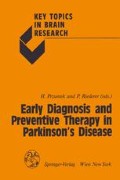Summary
Amantadine has a definite although minor place in the clinical management of parkinsonism. It is simple to administer, well tolerated by patients, with rapid if usually minor to moderate benefit rather than dramatic response, and with few serious adverse effects.
Access this chapter
Tax calculation will be finalised at checkout
Purchases are for personal use only
Preview
Unable to display preview. Download preview PDF.
References
Aoki FY, Stiver HG, Sitar DS, Boudreault A, Ogilvie R (1985) Prophylactic amantadine dose and plasma concentrations—effect relationships in healthy adults. Clin Pharmacol Ther 128: 128–136
Borison RL (1983) Amantadine in the management of extrapyramidal side effects. Clin Neuropharmacol 6 [Suppl] 1: S 57–63
Dallos V, Heathfield K, Stone P (1972) Use of amantadine in Parkinson’s disease. Result of a double-blind trial. Br Med J. 4: 24–26
Fasano VA, Urciuoli R, Broggi G (1970) Primo osservazioni sull’uso dell’amantadina per via endovenosa e dulla associazione dell’amantadina per via orale con farmaci anticolinergici e con levo-dopa nel trattamento della malattia di Parkinson. Minerva Med 61: 2895
Fünfgeld EW (1970) Amantadin-Wirkung bei Parkinsonismus. Dtsch Med Wochenschr 95: 1834–1836
Greenburg J (1971) Treatment of parkinsonism with amantadine hydrochloride. Pennsylv Med 74: 54
Hayden FG, Hoffman HE, Spyker DA (1983) Differences in side effects of amantadine hydrochloride and Amantadine hydrochloride relative to differences in pharmacokinetics. Antimicrob Agents Chemother 23: 458–464
Hunter KR, Stern GM, Laurence DR, Armitage P (1970) Amantadine in parkinsonism. Lancet i: 1127–1129
Kelly JT, Abazzahab FS (1971) The antiparkinsonian properties of amantadine in drug-induced parkinsonism. J Clin Pharmacol 11: 211
McEvoy JP (1987) A double-blind crossover comparison of antiparkinsonian drug therapy: amantadine versus anticholinergics in 90 normal volunteers, with an emphasis on differential effects on memory function. J Clin Psychiatr 48 [Suppl]: 20–23
Mann DC, Pearce LA, Waterbury LD (1971) Amantadine for Parkinson’s disease. Neurology 21: 958–962
Mindham RHS, Gaind R, Anstree BH, Rimmer L (1972) Comparison of amantadine, orphenadrine and placebo in the control of phenothiazineinduced parkinsonism. Psychol Med 2: 406
Parkes JD, Baxter RCH, Curzon G, Knill-Jones RP, Knott PJ, Marsden CD, Tattersall R, Vollum B (1971) Treatment of Parkinson’s disease with amantadine and levodopa. Lancet i: 1083–1085
Parkes JD, Baxter RB, Marsden CD, Rees JE (1974) Comparative study of amantadine, benzhexol and levodopa in the treatment of Parkinson’s disease. J Neurol Neurosurg Psychiatr 37: 422–426
Parkes JD, Zilkha KJ, Calver DM, Knill-Jones RP (1970) Controlled trial of amantadine hydrochloride in Parkinson’s disease. Lancet i: 259–262
Schwab RS, England AC, Poskanzer DC, Young RR (1969) Amantadine in the treatment of Parkinson’s disease. J Am Med Ass 208: 1168
Stetter H (1954) Die Chemie der organischen Ringsbetreme mit Utotropin-Struktur. Angew Chem 66: 217
Timberlake WH, Vance MA (1978) Four-year treatment of patients with parkinsonism using amantadine alone or with levodopa. Ann Neurol 3: 119–128
Völler G (1972) Zur Therapie des Parkinson-Syndroms mit Amantadin. Munch Med Wochenschr 14: 1066
Webster DD, Sawjer GT (1984) The combined use of amantadine HCI and levodopa/carbidopa in Parkinson’s disease. Curr Ther Res 35: 1010–1013
Author information
Authors and Affiliations
Editor information
Editors and Affiliations
Rights and permissions
Copyright information
© 1989 Springer-Verlag/Wien
About this paper
Cite this paper
Parkes, J.D. (1989). Clinical pharmacology of amantadine and derivatives. In: Przuntek, H., Riederer, P. (eds) Early Diagnosis and Preventive Therapy in Parkinson’s Disease. Key Topics in Brain Research. Springer, Vienna. https://doi.org/10.1007/978-3-7091-8994-8_39
Download citation
DOI: https://doi.org/10.1007/978-3-7091-8994-8_39
Publisher Name: Springer, Vienna
Print ISBN: 978-3-211-82080-3
Online ISBN: 978-3-7091-8994-8
eBook Packages: Springer Book Archive

